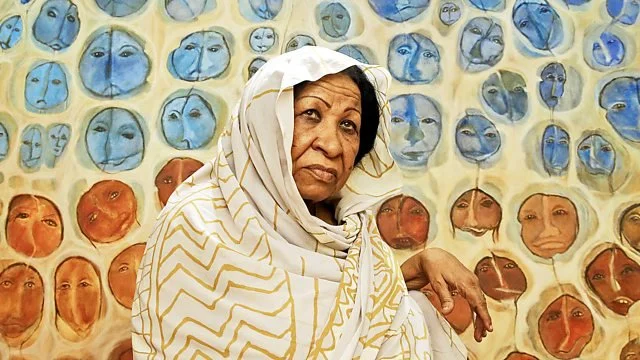Kamala Ibrahim Ishaq Through a Feminist Art History Lens
Words By Reenal Igboanugo
Feminist art history is a varied approach to art analysis that examines art made by women, art about women, and how art affects women. However, many aspects of the historical analysis of feminist art neglect intersectionality. I’m zooming in on a beloved artist born in Sudan in 1963 called Kamala Ibrahim Ishaq.
Kamala Ibrahim Ishaq attended the Sudanese Art School at the University of Khartoum and went on to continue her studies at the Royal College of Art in London. She returned to Khartoum to become a professor and exhibited her works across Sudan, and in Jordan, France, the UAE, the United Kingdom, and the United States. Together with her students Nayla Al-Tayib, and Mohammad Hameed Shadad, she founded the crystalists movement (كريستالستس or البلورية), a radical art movement that challenged the art spaces of Sudan.
The nature of Ishaq’s Training as an Artist & How it Differed From Other (Male) Artists
Visual art in Sudan is heavily influenced by both Islamic and colonial European perspectives. During the Anglo-Egyptian rule of Sudan, the British established an art school where Sudanese painters would be trained in European modes of painting (cubism, impressionism, etc.) However, these artists still took their Sudanese influences – which were both Islamic and pre-Islamic – with them into these schools, but worked within European standards. In contrast, Ishaq is known for painting and depicting female subjects through a woman’s eyes. In her painting “Zaar” (1973), the only reason we know the subjects of the painting are women is because the painting depicts a Zar ceremony: a secret cult in East Africa, localized to the Horn of Africa amongst women and some disenfranchised men (often homosexual). From a religious perspective, women who practice Zar are possessed by spirits and must go through ritual adorcism to placate their demons through playing music, yelling, dancing, and singing to please their demons. Looking at it sociologically, Zar is a way for disenfranchised women and men to gather and evade real problems like domestic abuse.
A good place to look at is Al-Bayan Al-Christali: a summary of the manifesto can be found in this quote, “The risk is magnified by the fact that the undoing of that repression and the liberation of man, and thus all forms of his creative activities and energies—arts and literature—would be achieved by negating the objective mind.” [Modern Art in the Arab World: Primary Documents: the Crystalist Manifesto]
Basically, to become part of a society one must forgo some of one's desires to fit into the space allotted for one's existence. The Crystalists believe that communities should be ever-expansive like the universe and the crystal, which is more attuned to our actual nature. Ishaq’s artistic beliefs are both for the artistically trained and for society at large: for the anointed Sufis of Sudan who are attuned to this sort of mystical thinking, for women in Sudan who are supposedly shunned from the arts and relegated to oppressive roles in society, for Muslims, the French, the British, those outside of Sudan, etc.
“The risk is magnified by the fact that the undoing of that repression and the liberation of man, and thus all forms of his creative activities and energies—arts and literature—would be achieved by negating the objective mind.”
It’s important to acknowledge that Ishaq rejects being constrained into any definitions and boxes throughout her artistic career. In one of her interviews with Dabanga – an independent news reporting site in Sudan – she answers disdainfully the question of her art as a reaction to male dominance in the art world: "That is not true! Women back then were doing far more than men in the art field in Sudan, I don’t know why people keep saying that.”
It is true that during her time teaching at the University of Khartoum, more women than men were enrolled in art schools. But let’s be real; male dominance is a reason for that shift. The shift from art being a male-dominated field to a female-dominated one is the denigration of art to become less important to society. Now women have a greater barrier to entry into stem fields rather than the humanities. Looking at Ishaq through feminist methodology is not an attempt to put her into the box of “Sudan's feminist painter.” Rather – taking after the methodologies proposed by the Crystalist movement – it’s to look at her through one perspective in a multitude. Picking the feminist method is, for multiple reasons, the most tantamount of them, considering the crimes against women currently being conducted in Sudan, where rape is being used as a war tactic. This analysis is to embrace Ishaq not as an emblem of feminism, but rather, to look at her art through the feminist perspective and multiplicity in Sudan that would please her.





